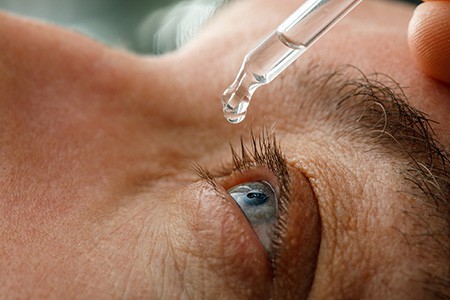
Dry eye disease affects millions of Americans as one of the most common issues with the ocular surface. This complex condition can be challenging to treat, depending on the cause of dry eyes, and often takes a combination approach of in-office treatments and at-home remedies. The ophthalmologists at our state-of-the-art facility offer the latest treatments for dry eye in 2023, including BlephEx, intense pulsed light (IPL) therapy, and meibomian gland imaging and treatment with iLux²®. Our dry eye specialists at Laser Eye Center™ can determine the cause of your dry eyes and develop a treatment plan to improve or eliminate symptoms.
Dry eye disease happens when there are not enough tears to lubricate the eyeball or an imbalance within the three layers of the tear film. The following dry eye treatments available in 2023 can target the source of your dry eyes or address painful symptoms.
iLux²® for Dry Eyes
Meibomian gland dysfunction (MGD) accounts for about 86% of dry eye disease cases and evaporative dry eye caused by tear film disruption. MGD is the most common cause of dry eye disease. These glands line the edges of the upper and lower eyelids and are responsible for secreting essential oil (meibum containing lipids) that lubricate the eye’s surface. The oil layer reduces friction on the eye and mixes with the water (aqueous) and mucous (mucin) layers for normal tear film and function. MGD prevents oil flow from the meibomian glands, causing rapid tear evaporation that leads to eyelid swelling, damage to the ocular surface, and dry eyes.
MGD treatment requires proper diagnosis and can be confused with other ocular surface disorders, such as eye allergies and ocular rosacea. iLux²® technology helps us understand the cause of your dry eye symptoms with advanced meibomian gland imaging, similar to what an X-ray image can reveal of your bone structure. This diagnostic tool and treatment option allows our dry eye specialists to see visuals of the blocked oil glands within the patient’s eyelid.
The Systane® iLux²® MGD treatment system may take as few as eight minutes to administer per eye, providing fast-acting and long-lasting symptom relief. The handheld device reveals the meibomian glands to evaluate dry eye, then delivers a gentle and non-invasive treatment using light energy and thermal pulsation that warms and puts gentle pressure on the eyelids. The combination of heat and pressure dislodges and unblocks the meibomian glands and leads to better oil flow and gland function that reduces dry eye symptoms and tear evaporation rates. After the treatment session, the iLux²® device has a magnifier for our eye doctors to examine the glands and expressed meibum (oil or lipids).
A 2022 study published in Clinical Optometry evaluated eyelid-warming devices, such as iLux, that place direct heat and pressure on the eyelids. Researchers included results from 58 clinical studies in humans and found that iLux and similar devices effectively improve dry eye symptoms, including severe cases of MGD. Not only is iLux technology safe to use for the diagnosis and treatment of MGD, but the tear film breakup time has been found to improve by more than 50% within the first two weeks of treatment and up to 80% or higher four weeks from the date of treatment. These are incredible gains! It is also worth noting that iLux addresses any inflammation caused by allergens in the eyelid region.
At Laser Eye Center™, we have seen incredible results with iLux²® for MGD, with some patients experiencing up to 50% improvement in tear film quality and function within two weeks.
BlephEx® for Dry Eyes
BlephEx® is an eyelid procedure that cleans the surface underneath to improve and maintain healthy eyelids. The in-office treatment increases eyelid hygiene and allows our dry eye specialists to remove excess bacteria, bacterial toxins, and biofilm that may be causing or contributing to eye discomfort and dryness. Regular treatments with BlephEx® help patients maintain clean eyelids, and many patients stay symptom-free. BlephEx® can also help fight allergies by removing the sticky microscopic allergens that tend to stubbornly line the eyelid regions.

The BlephEx® procedure is quick and painless. A handpiece spins a soft, medical-grade micro-sponge along the edge of the eyelashes and eyelids, removing years of built-up bacterial biofilm, much like a teeth cleaning removes plaque. Removing the biofilm with BlephEx® can restore normal tear production and lead to healthier functioning eyelids. Two disposable micro-sponges, one for each eye, are used with the BlephEx® handpiece to ensure fresh and clean eyelids after the six-to-eight-minute procedure.
Numbing drops decrease discomfort, and most patients feel tickling sensations during BlephEx® treatment. You can resume normal activities immediately, and maintenance sessions are recommended every four to six months. The sooner you start BlephEx®, the better your long-term results, because ongoing dry eyes and increasing eyelid biofilm can damage the tear glands. Cleansing the eyelids early and often improves tear function.
Intense Pulsed Light (IPL) Therapy for Dry Eyes
Intense pulsed light therapy treats evaporative dry eye and rosacea. The IPL handpiece contains filters that shine light through a flash lamp. The filtered light spectrum is absorbed by oxygen in red blood cells (oxyhemoglobin), which convert the light to heat that destroys blood vessels by targeting molecules that absorb visible light.
IPL treatment is painless and performed in the office. The handpiece delivers gentle light pulses to the skin around the eyes to eliminate bacteria and decrease inflammation. The pulsing light energy melts the thick secretions on the eyelid and releases the oil clogging the meibomian glands, stimulating natural oil flow and stabilizing the tear film.
The IPL process starts with placing a shield over the eyelids and applying a cooling gel on the treated skin. One of our dry eye specialists holds the small device over the eyelids to deliver light pulses. Afterward, our doctors may express some oil from the meibomian glands to dislodge and restore natural oil flow.
Most patients see dry eye improvement after the first or second IPL treatment, but at least four monthly treatments are recommended for best results. Severe cases of dry eye disease may need additional treatments or a combination approach with other methods.
Computer Vision Syndrome, Dry Eyes, & Blue Light Glasses
The connection between digital devices and dry eyes is strongly linked to how we use these technologies. Most people don’t take breaks from the computer screen during their workdays, and blink rates decrease by up to 50%. Blinking is essential for spreading tear film and preventing rapid tear evaporation, so many people have tired, dry eyes after long days in front of screens.
As such, following iLux and BlephEx® protocols are essential for modern-day vision health. In addition, a daily routine that incorporates preservative-free lubricant eye drops in conjunction with warm compresses is essential. That said, taking frequent breaks to rest your eyes, blinking more often, and adjusting brightness and contrast on your computer all provide relief.

Related to the above and as an additional indirect solution to the above interventions, blue light glasses are trending as well. These glasses are sold in stores and online, and some promise to alleviate dry eye symptoms.
Specifically, blue light glasses are recommended for three key reasons. Firstly, they provide essential eye protection by reducing eye strain and discomfort, which is especially beneficial for individuals who spend extended periods on digital devices. Secondly, these glasses aid in improving sleep quality by filtering out blue light, minimizing disruptions to circadian rhythms, and ensuring better rest for evening device users. Lastly, blue light glasses can boost productivity by enhancing overall comfort and reducing eye fatigue/inflammation, making them an invaluable tool for professionals and students seeking peak performance during screen-intensive tasks.
Treating Eye Allergies May Reduce Dry Eyes
Eye allergy symptoms overlap with dry eye disease, making diagnosis challenging, and many people live with both conditions. Red, irritated eyes accompanied by sneezing, sniffling, or a stuffy nose are typically caused by allergies. You may also experience burning, itching, and clear discharge. Effective treatment and diagnosis of eye allergies can improve dry eye symptoms and make dry eye treatments more effective.
Eye allergy treatments may include prescription eyedrops containing decongestants, antihistamines, mast cell stabilizers, corticosteroids, and NSAIDs. Other options include allergy shots and non-sedating oral antihistamines, but antihistamines may worsen dry eye symptoms.
Effective eye allergy treatment starts with diagnosis, which includes allergy testing and a comprehensive eye exam.
New Dry Eye Treatments on the Horizon
Several new dry eye treatments were approved by the FDA in 2023, including Miebo™ (NOV03), VEVYE™ (CyclASol), and Reproxalap. XDEMVY™ (TP-03) is another 2023 ophthalmic solution and a revolutionary treatment for Demodex blepharitis linked to dry eyes.
Meibo™
Miebo™ is a medication that targets meibomian gland dysfunction. It’s the first of its kind and the only eye drop approved for treating dry eye disease specifically. The active ingredient in Miebo™ is perfluorohexyloctane ophthalmic solution, which targets tear evaporation and not tear formation. Perfluorohexyloctane mimics the function of the meibomian glands in producing oil or lipids that reduce tear evaporation.
VEVYE™
VEVYE™ is the brand name of CyclASol®, also called EyeSol. This topical ophthalmic solution reduces inflammation on the eye’s surface, which affects tear production in dry eye patients. CyclASol® is a water-free anti-inflammatory drug that can survive much longer on the eye’s surface than other anti-inflammatories.
Reproxalap
Reproxalap inhibits reactive aldehyde species (RASP) involved in dry eye disease. RASP causes eye redness, inflammation, and changes in the oil layer of the tear film and decreases tear production. Reproxalap takes a novel approach to treating dry eyes. It’s a non-steroidal anti-inflammatory drug that aims to stabilize tear film by stopping RASP from harming tear lipids from the meibomian glands.
XDEMVY™
XDEMVY™ is a unique dry eye treatment because it targets a lesser-known link to dry eyes: Demodex blepharitis or eyelid inflammation caused by Demodex mites. Demodex mites are microscopic eight-legged parasites that live in hair follicles and oil glands on your face, neck, or chest. They’re mostly harmless and help skin health by removing dead skin cells, but they may damage the oil glands in the eyelids. Demodex blepharitis symptoms include swollen eyelids, itching, stinging or burning sensations, sticky eyelashes, and red and dry eyes. XDEMVY™ is a topical eye drop that paralyzes and exterminates the mites. The active ingredient, Lotilaner, paralyzes the nervous system of Demodex mites, effectively killing them.
Contact Laser Eye Center™ About New Dry Eye Treatments
Laser Eye Center™ is proud to offer the latest and most effective treatment options to help our patients with dry eye disease. Schedule an eye exam and dry eye consultation at one of our six office locations in SoCal, including Los Angeles County, Santa Clarita Valley, and Inland Empire. Call (800) 649-2659 to book your appointment with one of our experienced ophthalmologists today.
SOURCES:
- https://www.ophthalmologytimes.com/view/dry-eye-paradise-fda-green-lights-miebo-as-first-and-only-eye-drop-approved-for-the-condition
- https://www.medscape.com/viewarticle/992296
- https://www.reviewofoptometry.com/article/dry-eye-drugs-whats-new-and-whats-next
- https://ir.tarsusrx.com/news-releases/news-release-details/fda-approves-xdemvytm-lotilaner-ophthalmic-solution-025
- https://www.novaliq.com/press-releases/2023/06/08/novaliq-announces-fda-approval-of-vevye-cyclosporine-ophthalmic-solution-0-1-for-the-treatment-of-the-signs-and-symptoms-of-dry-eye-disease/
- https://www.healio.com/news/optometry/20230310/qa-2023-will-be-an-exciting-year-with-new-dry-eye-disease-treatments-in-the-pipeline
- https://www.reviewofoptometry.com/article/motivate-your-patients-with-meibomian-gland-imaging-techniques
- https://ilux.myalcon.com/
- https://www.ncbi.nlm.nih.gov/pmc/articles/PMC9362510/
- https://www.sciencedirect.com/science/article/abs/pii/B9780323827539000047?via%3Dihub
- https://blephex.com/patients/index.php/how-does-blephex-work.html
- https://blephex.com/patients/
- https://eyewiki.aao.org/Intense_Pulsed_Light_(IPL)_Therapy#
- https://www.lasereyecenter.com/can-blue-light-lenses-cure-dry-eye/
- https://health.clevelandclinic.org/do-blue-light-blocking-glasses-actually-work/
- https://acaai.org/allergies/allergic-conditions/eye-allergy/
- https://www.optometrists.org/general-practice-optometry/guide-to-eye-conditions/dry-eye/conjunctivitis-and-eye-infections/dry-eyes-what-is-intense-pulsed-light-therapy/#:~:text=Intense%20pulsed%20light%20(IPL)%20therapy,quantity%20or%20inadequate%20tear%20quality.
- https://pubmed.ncbi.nlm.nih.gov/32007978/
Schedule your free consult today
Click here to learn moreGet started on your journey to clearer, crisper vision with Laser Eye Center™. Our expert team of doctors are trained and skilled in the latest technology and methods for laser vision correction. To learn more about our state-of-the-art All Laser LASIK technology or about All Laser LASIK itself, contact us today. Schedule your FREE All Laser LASIK consultation by calling today.

